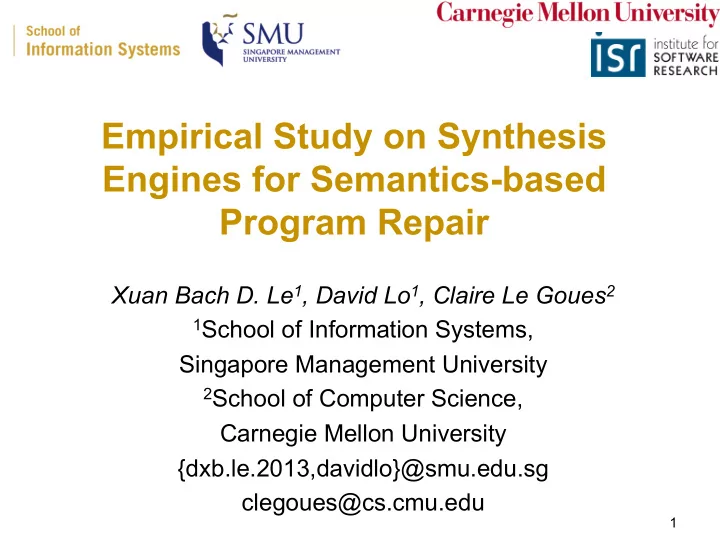

Empirical Study on Synthesis Engines for Semantics-based Program Repair Xuan Bach D. Le 1 , David Lo 1 , Claire Le Goues 2 1 School of Information Systems, Singapore Management University 2 School of Computer Science, Carnegie Mellon University {dxb.le.2013,davidlo}@smu.edu.sg clegoues@cs.cmu.edu 1
SE@CMU is recruiting graduate students! • Send us your awesome undergrads! • Tell them to check the box next to “PhD in Software Engineering”, so we’re certain to see them! • Early deadline: December 1 • Final, we-mean-it deadline: December 15. 2
Automatic patch generation seeks to improve software quality. • Bugs in software incur tremendous maintenance cost. In 2006, everyday, almost 300 bugs appear in Mozilla [ … ] far too much for programmers to handle • Developers presently debug and fix bugs manually. • Automated program repair: APR = Fault Localization + Repair Strategies 3
Semantics-based repair extracts value-based specifications using tests + symbolic execution, constructs patches using synthesis. No Pases Specs all tests? Yes Program Synthesis Mechtaev et al.. Angelix: scalable multiline program patch synthesis via symbolic analysis. In ICSE '16.
Our contributions: • Pluggable framework to assess many types of syntax-guided program synthesis in the core of Angelix. • Evaluation of different synthesis techniques for semantic program repair. – Key finding: effectiveness of different synthesis engines varies! 5
Syntax Guided Program Synthesis (SyGuS) : use a restricted grammar to describe syntactic space of possible solutions • Use different search techniques to search for solutions conforming to provided grammar • We evaluate: Enumerative, Stochastic, Symbolic, and CVC4
Example of Buggy Program bool min(int x, int y){ bool cond = x < y; if(cond){ Test # Value Value Expected return true; of x of y output }else{ 1 1 2 true return false; FAILED 2 2 2 true } 3 5 2 false } 7
Selective Symbolic Execution bool min(int x, int y){ Replace buggy expression by bool cond = α ; symbolic variable if(cond){ ü Switch to symbolic execution when return true; necessary, collect path conditions. ü Infer specs for each test }else{ x y expected return false; 2 2 true } PC2: (not α ) & x = 2 & y = 2 & } expected output[true] = actual output[false] PC1: α & x = 2 & y = 2 & expected output[true] = actual output[true] 8
Extract Value-based Specifications Satisfiable PC1: α & x = 2 & y = 2 & expected output[true] = actual output[true] Unsatisfiable PC2: (not α ) & x = 2 & y = 2 & expected output[true] = actual output[false] Model: x = 2 & y = 2 & α = true Post-condition: α = true Pre-condition: x = 2 & y = 2 Synthesize α over x and y, permitting a restricted set of components, satisfying spec 9
Public domain, CC0, Hard constraints on functionality + soft constraints on form + PartialMax SMT = minimal repair (mathy details elided for brevity.) 10
Our framework converts specs inferred by Angelix to generic SyGuS format. Optimizations for generating minimal patch SyGuS Engine 1 SyGuS SyGuS Value-based Patch format Engine 2 Specs 11
Experiments • 188 programs from IntroClass benchmark – Use black-box tests for repair, white-box tests for testing quality of generated patches. – Only report the patches that generalize to the held-out tests! • Synthesis techniques that help generate more correct patches are better • Evaluate on: Enumerative, Stochastic, Symbolic, CVC4, and Angelix’s synthesis engine 12
Synthesis techniques vary in the bugs they can correctly address. 13
Summary • We evaluate the effectiveness of different synthesis techniques in the context of program repair, finding: – Performance of synthesis techniques varies – Forging results of synthesis techniques increases effectiveness of program repair, e.g., fix more bugs • We plan to develop more effective synthesis techniques for repair. Code: https://github.com/xuanbachle/syntax-guided-synthesis-repair 14
Recommend
More recommend